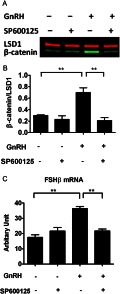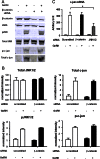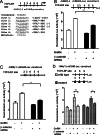β-catenin regulates GnRH-induced FSHβ gene expression
- PMID: 23211523
- PMCID: PMC3683805
- DOI: 10.1210/me.2012-1310
β-catenin regulates GnRH-induced FSHβ gene expression
Abstract
The regulation of gonadotropin synthesis by GnRH plays an essential role in the neuroendocrine control of reproduction. The known signaling mechanisms involved in gonadotropin synthesis have been expanding. For example, involvement of β-catenin in LHβ induction by GnRH has been discovered. We examined the role of β-catenin in FSHβ gene expression in LβT2 gonadotrope cells. GnRH caused a sustained increase in nuclear β-catenin levels, which was significantly reduced by c-Jun N-terminal kinase (JNK) inhibition. Small interfering RNA-mediated knockdown of β-catenin mRNA demonstrated that induction of FSHβ mRNA by GnRH depended on β-catenin and that regulation of FSHβ by β-catenin occurred independently of the JNK-c-jun pathway. β-Catenin depletion had no impact on FSHβ mRNA stability. In LβT2 cells transfected with FSHβ promoter luciferase fusion constructs, GnRH responsiveness was conferred by the proximal promoter (-944/-1) and was markedly decreased by β-catenin knockdown. However, none of the T-cell factor/lymphoid enhancer factor binding sites in that region were required for promoter activation by GnRH. Chromatin immunoprecipitation further corroborated the absence of direct interaction between β-catenin and the 1.8-kb FSHβ promoter. To elucidate the mechanism for the β-catenin effect, we analyzed approximately 1 billion reads of next-generation RNA sequencing β-catenin knockdown assays and selected the nuclear cofactor breast cancer metastasis-suppressor 1-like (Brms1L) as one candidate for further study. Subsequent experiments confirmed that Brms1L mRNA expression was decreased by β-catenin knockdown as well as by JNK inhibition. Furthermore, knockdown of Brms1L significantly attenuated GnRH-induced FSHβ expression. Thus, our findings indicate that the expression of Brms1L depends on β-catenin activity and contributes to FSHβ induction by GnRH.
Figures







Similar articles
-
Extracellular signal-regulated kinase, Jun N-terminal kinase, p38, and c-Src are involved in gonadotropin-releasing hormone-stimulated activity of the glycoprotein hormone follicle-stimulating hormone beta-subunit promoter.Endocrinology. 2004 May;145(5):2228-44. doi: 10.1210/en.2003-1418. Epub 2004 Jan 21. Endocrinology. 2004. PMID: 14736735
-
Effects of estradiol and progesterone on gonadotropin LHβ- and FSHβ-subunit promoter activities in gonadotroph LβT2 cells.Neuro Endocrinol Lett. 2012;33(6):608-13. Neuro Endocrinol Lett. 2012. PMID: 23160221
-
Growth differentiation factor 9 (GDF9) forms an incoherent feed-forward loop modulating follicle-stimulating hormone β-subunit (FSHβ) gene expression.J Biol Chem. 2014 Jun 6;289(23):16164-75. doi: 10.1074/jbc.M113.537696. Epub 2014 Apr 28. J Biol Chem. 2014. PMID: 24778184 Free PMC article.
-
Regulation of gonadotropin subunit genes in tilapia.Comp Biochem Physiol B Biochem Mol Biol. 2001 Jun;129(2-3):489-502. doi: 10.1016/s1096-4959(01)00345-1. Comp Biochem Physiol B Biochem Mol Biol. 2001. PMID: 11399484 Review.
-
Regulation of fish gonadotropins.Int Rev Cytol. 2003;225:131-85. doi: 10.1016/s0074-7696(05)25004-0. Int Rev Cytol. 2003. PMID: 12696592 Review.
Cited by
-
Cytogenetic, Genomic, and Functional Characterization of Pituitary Gonadotrope Cell Lines.J Endocr Soc. 2019 Mar 25;3(5):902-920. doi: 10.1210/js.2019-00064. eCollection 2019 May 1. J Endocr Soc. 2019. PMID: 31020055 Free PMC article.
-
β-catenin stabilization in gonadotropes impairs FSH synthesis in male mice in vivo.Endocrinology. 2015 Jan;156(1):323-33. doi: 10.1210/en.2014-1296. Endocrinology. 2015. PMID: 25343272 Free PMC article.
-
Female-specific induction of rat pituitary dentin matrix protein-1 by GnRH.Mol Endocrinol. 2013 Nov;27(11):1840-55. doi: 10.1210/me.2013-1068. Epub 2013 Oct 1. Mol Endocrinol. 2013. PMID: 24085820 Free PMC article.
-
Modeling and high-throughput experimental data uncover the mechanisms underlying Fshb gene sensitivity to gonadotropin-releasing hormone pulse frequency.J Biol Chem. 2017 Jun 9;292(23):9815-9829. doi: 10.1074/jbc.M117.783886. Epub 2017 Apr 6. J Biol Chem. 2017. PMID: 28385888 Free PMC article.
-
GLUT1-mediated glycolysis supports GnRH-induced secretion of luteinizing hormone from female gonadotropes.Sci Rep. 2020 Aug 3;10(1):13063. doi: 10.1038/s41598-020-69913-z. Sci Rep. 2020. PMID: 32747664 Free PMC article.
References
-
- Pierce JG, Parsons TF. 1981. Glycoprotein hormones: structure and function. Annu Rev Biochem 50:465–495 - PubMed
-
- Burger LL, Haisenleder DJ, Dalkin AC, Marshall JC. 2004. Regulation of gonadotropin subunit gene transcription. J Mol Endocrinol 33:559–584 - PubMed
-
- Alarid ET, Windle JJ, Whyte DB, Mellon PL. 1996. Immortalization of pituitary cells at discrete stages of development by directed oncogenesis in transgenic mice. Development 122:3319–3329 - PubMed
-
- Pernasetti F, Vasilyev VV, Rosenberg SB, Bailey JS, Huang HJ, Miller WL, Mellon PL. 2001. Cell-specific transcriptional regulation of follicle-stimulating hormone-β by activin and gonadotropin-releasing hormone in the LβT2 pituitary gonadotrope cell model. Endocrinology 142:2284–2295 - PubMed
-
- Thomas P, Mellon PL, Turgeon J, Waring DW. 1996. The L β T2 clonal gonadotrope: a model for single cell studies of endocrine cell secretion. Endocrinology 137:2979–2989 - PubMed
Publication types
MeSH terms
Substances
Grants and funding
LinkOut - more resources
Full Text Sources
Other Literature Sources
Molecular Biology Databases
Research Materials
Miscellaneous

